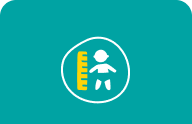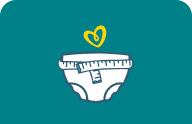Baby Teeth Chart: Timeline for Eruption & Care Tips
As your baby grows, one of the sweetest milestones to look forward to is the arrival of those tiny, first teeth. While teething can sometimes be challenging for babies (and parents), the bright side is that those adorable toothy grins are on the horizon.
In this article, you’ll learn when to expect your baby’s first tooth, the order in which the rest will appear, and at what age. Plus, our baby teeth chart will guide you in identifying each new tooth as it comes in!
Baby Teeth Chart: In What Order Do Baby Teeth Appear and Fall Out?
A baby teeth chart is a handy tool to track when your little one’s first set of teeth—known as primary teeth, baby teeth, or deciduous teeth—is expected to appear and later fall out.
While every child’s timeline is slightly different, baby teeth usually begin to come in around 6 months of age and start to fall out between ages 6 and 12, making way for permanent teeth. The baby teething chart below provides a helpful overview of both the dental eruption and shedding stages, giving you a clear idea of what to expect.
Every child is unique, so the timeline may vary slightly. If you’re concerned about when your baby’s teeth fall out, consult your child’s healthcare provider or dentist.
When do Babies Start Teething?
If you’re wondering, “When do babies get their teeth?”, teething usually begins around the ages of 6 to 12 months, although for some babies a tooth can appear as early as 4 months or as late as after the first birthday.
In most cases, the first teeth to emerge are the central incisors—the two front teeth—on either the top or bottom row. These first tiny teeth mark the start of an exciting journey toward a full set of primary teeth.
When do Molars Come In?
Molars tend to come in later than the front teeth and play an important role in chewing. Your baby’s first molars usually appear between 13 and 19 months, followed by the second molars closer to their second birthday.
Here’s a general timeline for when molars erupt and eventually fall out:
Upper first molars: Erupt between 13 and 19 months, fall out around 9 to 11 years
Upper second molars: Erupt between 25 and 33 months, fall out around 10 to 12 years
Lower first molars: Erupt between 14 and 18 months, fall out around 9 to 11 years
Lower second molars: Erupt between 23 and 31 months, fall out around 10 to 12 years
All primary teeth, including molars, usually come in gradually until around age 3, when most children have a complete set of 20—10 on the top and 10 on the bottom.
If you’re ever unsure about the timing or order of your child’s teeth, your healthcare provider or dentist can help guide you.
How Many Teeth Do Babies and Kids Have in Total?
Wondering how many baby teeth your child will have? In total, babies develop 20 primary teeth—10 on the upper jaw (top teeth) and 10 on the lower jaw (bottom teeth). These teeth usually emerge gradually, with a full set typically in place by age 3.
Your little one’s mouth will gradually become filled with these teeth up until the age of 3. Then, these primary teeth will begin falling out around the age of 6 to make way for your child’s adult teeth.
What Are the Signs of Teething in Babies and Toddlers?
Recognizing the signs of teething can help you better understand what your little one is experiencing. Some common baby teething symptoms include:
Irritability. Your baby might seem fussier or cry more than usual due to gum discomfort.
Disturbed sleep. Teething discomfort can cause your baby to wake up more frequently at night.
Increased drooling. Excessive drooling is often a sign that a tooth is about to erupt.
Chewing on objects. Babies may gnaw on toys, fingers, or teething rings to relieve gum pressure.
Sore, swollen gums. The area around the emerging tooth may appear red or tender.
These baby teething symptoms typically start a few days before a tooth emerges and subside once it breaks through the gums. Keep in mind that every baby is different—some may show multiple symptoms, while others experience teething with minimal signs. If you’re unsure or concerned, consult your little one’s healthcare provider.
How to Help Soothe Your Baby While Teething
For some babies, teething is painless, but for others, it may occasionally cause mild irritability, crying, and even a low-grade temperature.
The discomfort usually stems from swollen and tender gums as new teeth erupt. How long does teething pain last? In most cases, it is temporary, often lasting just a few days before or after a tooth emerges. However, when it comes to how long teething lasts, the process spans months as each tooth works its way through the gums.
If your baby is showing signs of discomfort, there are several ways to help ease your baby’s teething pain. You can:
Offer a cooling object to chew on. Teething toys or even a chilled (not frozen) washcloth can help soothe tender gums,
Gently massage their gums. Use a clean finger to rub your baby’s gums lightly, which can provide temporary relief.
Provide distraction. A new toy or activity can take their mind off the discomfort.
When to Start Brushing Your Baby’s Teeth
Start brushing your baby’s first tooth twice a day using a smear of fluoride toothpaste, about the size of a grain of rice, especially after their last meal. As your little one grows, they might resist having their teeth brushed, check out ways to make brushing their teeth fun! Your child should see a dentist 6 months after eruption of their first tooth, or by age 12 months, whichever is first.
At age 3, switch to a pea-sized amount of fluoride toothpaste. Supervise brushing until your child can spit out toothpaste and brush independently, typically around age 7 or 8.
Starting this routine early sets the foundation for healthy teeth.
The Bottom Line
It’s always exciting to see that first baby tooth and a baby teeth chart can give you a rough idea of when the rest will arrive. Keep in mind that every baby’s timeline is unique, and your little one’s teeth may follow a slightly different order.
As your baby’s teeth come in, you might find it helpful to learn about how to care for their teeth and when to schedule their first dentist visit.
Don’t forget to check out the Pampers Club app to enjoy rewards and discounts as you care for your baby’s growing smile.
How we wrote this article The information in this article is based on expert advice found in trusted medical and government sources, such as the American Academy of Pediatrics, the American Academy of Pediatric Dentistry, and the American College of Obstetricians and Gynecologists. You can find a full list of sources used for this article below. The content on this page should not replace professional medical advice. Always consult medical professionals for full diagnosis and treatment.
Join a World of Support
through Pregnancy and Parenthood.
TRACK WITH TOOLS
LEARN WITH EXPERTS
GET REWARDED













